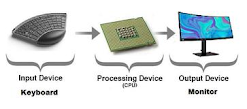Types of Computer Hardware
Computer hardware refers to the physical components that make up a computer system. There are many different types of computer hardware, and each one has a specific function. Some of the most common types of computer hardware are:
- Input devices: These are devices that allow the user to enter data or commands into the computer. Examples of input devices are keyboard, mouse, scanner, microphone, and webcam.
- Output devices: These are devices that display or produce the results of the computer's processing. Examples of output devices are monitor, printer, speaker, and projector.
- Processing devices: These are devices that perform calculations and operations on the data. The main processing device is the central processing unit (CPU), which is the brain of the computer. Other processing devices are graphics card, sound card, and network card.
 - Desktop computers: These are personal computers that are designed to be used on a desk or table. They consist of a separate system unit and peripherals, such as monitor, keyboard, mouse, etc. Desktop computers are usually more powerful and expandable than other types of computers, but they are also less portable and consume more power.
- Desktop computers: These are personal computers that are designed to be used on a desk or table. They consist of a separate system unit and peripherals, such as monitor, keyboard, mouse, etc. Desktop computers are usually more powerful and expandable than other types of computers, but they are also less portable and consume more power.- Laptop computers: These are personal computers that are designed to be used on the lap or on a flat surface. They combine the system unit and peripherals into a single unit that can be folded and carried around. Laptop computers are usually less powerful and expandable than desktop computers, but they are also more portable and consume less power.
- Tablet computers: These are personal computers that are designed to be used by touching the screen with a finger or a stylus. They do not have a keyboard or mouse, but they may have other input/output devices, such as camera, microphone, speaker, etc. Tablet computers are usually less powerful and expandable than laptop computers, but they are also more portable and consume less power.
- Smartphone computers: These are personal computers that are designed to be used as mobile phones. They have a small screen and a touch-sensitive keypad or keyboard. They also have other input/output devices, such as camera, microphone, speaker, etc. Smartphone computers can perform many functions of a computer, such as browsing the web, sending emails, playing games, etc., but they are also less powerful and expandable than tablet computers.
Computer hardware is constantly evolving and improving to meet the changing needs and demands of users. New types of computer hardware may emerge in the future that will offer better performance, functionality, and convenience. In the next we discuss and learn about the computer evolution and development of computer and types of software, etc.














